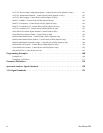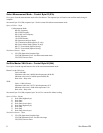
Programming Overview
NOTE: This programming manual is written exclusively for Anritsu Site Master Models S331D and
S332D. For information on firmware upgrades, contact your local Anritsu Service Center. Commands
listed in this manual are not all backward-compatible with earlier Anritsu models.
General Description
The Site Master must first be set into “remote” mode for communication with a computer. Remote mode differs from normal
repetitive sweep and single-sweep modes. During remote mode, the Site Master suspends normal operations and attends to
the serial port. The front panel display indicates when the Site Master is in remote mode.
Once in remote mode, a series of control bytes and associated data are sent to the Site Master to perform various functions
and activities. The serial port supports virtually all features accessible from the keypad with the exception of the printer. The
printer requires connection to the same 9-pin connector on the Site Master rear panel used for remote communication.
To complete the communication session, send the control byte to exit remote mode and the Site Master will resume normal
operations. You may also exit the remote mode by pressing the ESCAPE/CLEAR key on the Site Master front panel.
Interface Cable Installation
The Site Master is a DTE-type serial device. Communication between the Site Master and a PC is accomplished over a null
modem serial cable provided with the Site Master (Anritsu part number 800-441). Connect the cable to the Serial Interface
connector on the Site Master test connector panel and to the appropriate COM port connector on the PC.
Serial Communication Parameters
The Site Master begins communication at 9600 bps when first powered on. It uses no parity bits, 8 data bits, and 1 stop bit
(N-8-1). No hardware handshaking is used. The Set Baud Rate Control Byte #197 (C5h) serial command can be used to
change the baud rate to 19,200, 38,400, 56,000 or 115,200. An invalid setting returns the rate to 9600.
Communications Error Checking
Since there is no hardware handshaking, byte level error handling must be done by the controlling program. Use the expected
number of response bytes (listed in the control byte description section of this manual) when waiting for feedback from the
Site Master. For data streams going to the Site Master, the “watch dog timer” protects against interrupted transmissions by
aborting a control byte sequence if the inter-byte time limit is exceeded.
Parameter Validation
The Site Master validates input parameters for each control byte sequence. If the input parameters are out of range or invalid,
the Site Master notifies the computer by sending Parameter Error Byte #224 (E0h). The Site Master discards the received
data and waits for the next control byte.
Entering Remote Mode
Send the Enter Remote Mode Byte #69 (45h) to the Site Master to enter remote mode at the end of the current sweep. Send
the Enter Remote Mode Immediately byte #70 (46h) to enter remote mode in the middle of a sweep.
The Site Master serial port buffer is one byte wide. No internal buffer exists, so waiting for the response from the unit is es
-
sential. If the Site Master is not in remote mode, sending a second byte overwrites the original byte commanding it to enter
remote mode. If control byte #69 is sent, the Site Master will enter remote mode at the end of the current sweep. If control
byte #70 is sent, the unit will enter remote mode as soon as it receives the byte. This means that data stored for the current
sweep may be incomplete. Once a response string is received from the Site Master, the unit is ready to accept additional con
-
trol bytes.
Site Master PM 1


















